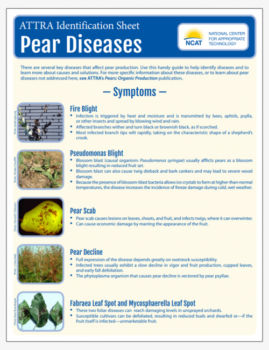ATTRA Identification Sheet: Pear Diseases
By Guy K. Ames and Holly Born, NCAT Agriculture Specialists
There are several key diseases that affect pear production. Use this handy guide to help identify diseases and to learn about causes and solutions. For more specific information about these diseases, or to learn about pear diseases not addressed here, see the ATTRA publication Pears: Organic Production.
Symptoms

Fire blight. Photo: Florida Division of Plant
Industry Archive, Florida Department of Agriculture and Consumer Services
Fire Blight
Infection is triggered by heat and moisture and is transmitted by bees, aphids, psylla, or other insects and spread by blowing wind and rain.
Affected branches wither and turn black or brownish black, as if scorched.
Most infected branch tips wilt rapidly, taking on the characteristic shape of a shepherd’s crook.
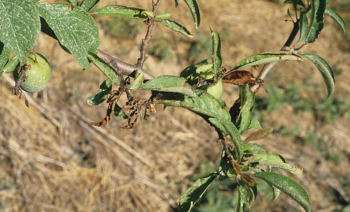
Blossom blast. Photo: Ontario Crop IPM
Pseudomonas Blight (Blossom Blast)
Blossom blast (causal organism: Pseudomonas syringae) usually afflicts pears as a blossom blight resulting in reduced fruit set.
Blossom blast can also cause twig dieback and bark cankers and may lead to severe wood damage.
Because the presence of blossom-blast bacteria allows ice crystals to form at higher-than-normal temperatures, the disease increases the incidence of freeze damage during cold, wet weather.
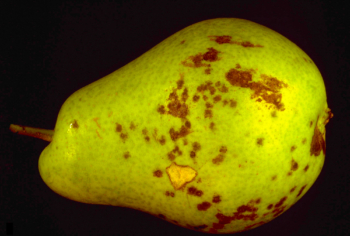
Pear scab. Photo: Howard F. Schwartz
Pear Scab
Pear scab causes lesions on leaves, shoots, and fruit, and infects twigs, where it can overwinter.
Can cause economic damage by marring the appearance of the fruit.
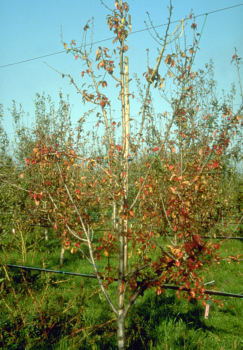
Pear decline. Photo: L. Giunchedi
Pear Decline
Full expression of the disease depends greatly on rootstock susceptibility.
Infected trees usually exhibit a slow decline in vigor and fruit production, cupped leaves, and early fall defoliation.
The phytoplasma organism that causes pear decline is vectored by pear psyllae.
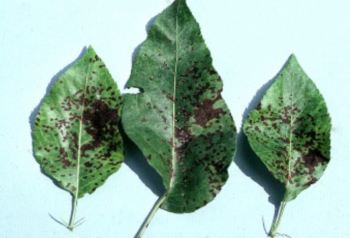
Fabraea leaf spot. Photo: Dave Rosenberger
Fabraea Leaf Spot and Mycosphaerella Leaf Spot
These two foliar diseases can reach damaging levels in unsprayed orchards.
Susceptible cultivars can be defoliated, resulting in reduced buds and dwarfed or—if the fruit itself is infected—unmarketable fruit.
Key Low-Spray and Organic Solutions
Fire Blight
Cultural practices that favor only moderate growth of trees are recommended, including using only half as much compost as for apples, never using fresh manure, and avoiding heavy understory populations of legumes. Avoid heavy pruning. Choosing fire-blight-resistant pear cultivars is a good start to managing fire blight. Biocontrols, non-pathogenic competitors with E. amylovora, occupy the same sites provided they get there first. In order to be effective, these should be applied to newly opening flowers. Bordeaux mix (copper sulfate and lime) and other copper formulations sprayed at green-tip stage are organic options that provide some protection from fire blight infection. Once fire-blight infection has occurred, there is no spray or other treatment, beyond quickly cutting out newly infected limbs, that will minimize damage.
Pseudomonas Blight (Blossom Blast)
Controlling this disease is difficult because its occurrence is widespread on many plant species and not easily predicted; once symptoms appear, control efforts are too late. Protecting orchards from frost damage can limit injury. An early application of BlightBan A506 can help reduce frost-damage potential by excluding the ice-nucleating bacteria. Application of fixed copper at the green-tip stage followed by streptomycin at early bloom has provided reasonable control in some regions.
Pear Scab
Pear cultivars differ in their susceptibility to scab. Organic control usually consists of treatment with sulfur, lime sulfur, or Bordeaux mixture. The Mills Table can be used to predict infection periods.
Pear Decline
Pear decline can be spread by grafting and budding with infected propagation wood, but is vectored by pear psyllae. Good pear-psylla control can prevent the disease and even results in disease remission. Many rootstocks are resistant. Other control methods include keeping the tree in good vigor with proper weed control, water management, and fertilization.
Fabraea Leaf Spot (Fabraea maculata) and Mycosphaerella Leaf Spot
Sprays for pear scab, such as Bordeaux mixture, will generally control these two maladies as well. Also, Surround™, a kaolin-clay-based insect repellant, is registered and labeled for suppression of fabraea leaf spot.
ATTRA Identification Sheet: Pear Diseases
By Guy K. Ames and Holly Born, NCAT Agriculture Specialists
Published November 2014
©NCAT
IP479, slot 491
This publication is produced by the National Center for Appropriate Technology through the ATTRA Sustainable Agriculture program, under a cooperative agreement with USDA Rural Development. ATTRA.NCAT.ORG.

